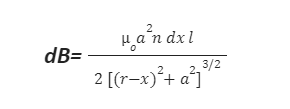Bar magnets are just a type of magnets that are rectangular. Bar magnets bear the same properties as a magnet. We also hypothesise that our earth contains a massive bar magnet inside its core. The north and south poles of a magnet are determined to correspond to the poles of the earth’s magnet. A solenoid is a device that acts like a magnet. It follows the similar theory of electromagnets.
Properties and uses of a bar magnet
After knowing what a bar magnet is, let us discuss its properties and uses.
Properties
The bar magnet comprises two poles: the north and south poles.
Like a magnet, the bar magnet can attract iron and steel particles.
Uses
Bar magnets are used in magnetic compasses.
The magnet of a fridge is a bar magnet.
Bar magnets are used in medical fields to scan the body. MRI is performed using bar magnets.
What is a solenoid?
Answering what is solenoid is just as important as answering what a bar magnet is? In simple terms, a solenoid is a device made up of coils of wire. The primary constituents are the coil of wire, a solid housing, and an extended moveable plunger or an armature. The shape of a solenoid is mostly cylindrical. According to electromagnetism, when we pass an electric current through the coil, it generates a magnetic field that draws in the plunger. Precisely, A solenoid converts electrical energy into mechanical energy through magnetism.
Features of a solenoid
The coil of wire in a solenoid is created by tight copper wire. The wire is turned many times. A magnetic field is deployed upon passing an electric current through it, encircling it. The strength of the magnetic field or flux is very high.
The housing of the solenoid is generally made of iron or steel. This housing concentrates the magnetic flux increasing the solenoid’s efficiency.
The magnetic field generated attracts the plunger inwards when a current is passed. Magnetism does mechanical work to pull or push the plunger.
Applications
A solenoid is usually used as a switch. It is used in electromagnets, inductors, valves, antennas, etc. Its variety makes it famous in industries such as medical, industrial, and locking systems.
A solenoid can be used in controlling electric valves. The mechanical force produced in solenoids is applied to the valve.
The most modern door locking system uses a solenoid. Electromagnetic locks are composed of solenoids and offer maximum security.
In industries, they form the components of computer printers and fuel injection systems found in cars, etc.
The fundamental advantage of using a solenoid is that the mechanical force is exerted immediately without any delay upon applying electric energy.
How does a solenoid behave like a magnet?
When current is passed through the coils of a solenoid, it behaves like a magnet. The magnetic flux is responsible for magnetic attraction. Each turn of the coil of a solenoid has its north and south pole. But they are coiled in such a helical way that the charges get cancelled out. Only the charge at the coil’s start and end remains, constituting the north and south poles. The positions of the north and south poles can be determined by bringing a bar magnet close to them. Unlike bar magnets, the north and south poles of a solenoid can be changed.
Experiment to show how to make a bar magnet as an equivalent solenoid
The magnetic field lines of a solenoid closely relate to that of a bar magnet. If we prove that the magnitude of the magnetic moment of a bar magnet is equal to that of a solenoid, we can show the bar magnet as an equivalent solenoid.
Let us assume:
A cylindrical solenoid of length 2l having a centre O.
We will measure the magnetic moment at point P on the axis of the solenoid. The distance of point P from the centre O is r.
We will take (a) as the area of the solenoid.
We will take n as the number of coils turns per unit length.
We assume a small thickness of dx at a distance of x from the centre O.
The current passing is taken as I.
The number of turns in that small thickness will be n.dx. To measure the magnitude of the magnetic moment, B of that small thickness, the formula will be:
Upon solving this formula by integration, the final results come as
When we measure the magnetic moment of a bar magnet from an axial point, the expression we get is
which is the same as that of the solenoid. This proves the bar magnet is an equivalent solenoid.
Conclusion
This article closely discussed what a bar magnet is and how its magnetic moment is similar to a solenoid. The uses and importance of solenoids are innumerable. A solenoid behaves like a magnet showing attractive characteristics and the north and south poles. But in practicality, solenoids are much better. To gain more knowledge about this topic, one should also read how solenoids are made.
 Profile
Profile Settings
Settings Refer your friends
Refer your friends Sign out
Sign out









